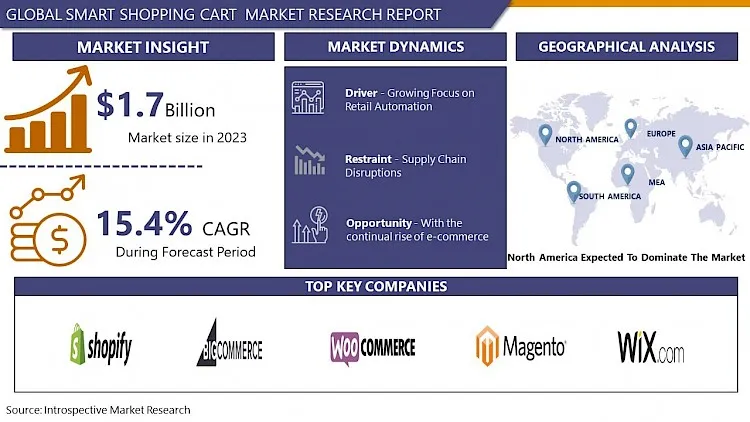Smart Shopping Cart Market Synopsis
Smart Shopping Cart Market Size Was Valued at USD 1.7 Billion in 2023 and is Projected to Reach USD 6.17 Billion by 2032, Growing at a CAGR of 15.4 % From 2024-2032.
Smart shopping carts have emerged as a revolutionary solution in the retail industry, combining technology and convenience to enhance the shopping experience for consumers and retailers alike. These carts are equipped with various sensors, cameras, and software that enable functionalities like automatic item scanning, personalized recommendations, and seamless checkout processes.
Smart shopping carts is their ability to automatically scan items as they are placed inside the cart, eliminating the need for manual barcode scanning at checkout. This not only saves time for shoppers but also reduces errors and streamlines the checkout process. Additionally, smart cards can provide real-time product information, such as pricing and nutritional details, helping shoppers make more informed purchasing decisions. Smart shopping carts often incorporate AI algorithms to analyze shopping patterns and offer personalized recommendations to customers based on their preferences and past purchases. This targeted approach not only enhances the shopping experience but also increases sales for retailers by promoting relevant products to shoppers.
Retailers also benefit from smart shopping carts through improved inventory management and operational efficiency. The data collected by these carts can be used to optimize store layouts, stock replenishment, and marketing strategies. Furthermore, by automating certain aspects of the checkout process, retailers can reduce labor costs and improve overall productivity. The smart shopping cart market is experiencing rapid growth, driven by increasing consumer demand for convenient shopping experiences and retailers' efforts to stay competitive in the digital age. Major players in the market include technology companies, retailers, and startups, all vying to capture a share of this burgeoning market.

Smart Shopping Cart Market Trend Analysis
Growing Focus on Retail Automation
- The Smart Shopping Cart market is experiencing a surge in growth, largely propelled by the escalating focus on retail automation. In recent years, retailers have been increasingly investing in technological advancements to enhance the shopping experience and streamline operations. Smart shopping carts represent a significant innovation in this regard, offering a range of benefits for both retailers and consumers.
- The growing adoption of smart shopping carts is the desire to improve efficiency and convenience in the shopping process. These carts are equipped with various sensors, cameras, and other technologies that enable features such as automatic item scanning, real-time inventory tracking, and personalized recommendations. By automating mundane tasks such as scanning barcodes and tallying up purchases, smart shopping carts reduce checkout times and enhance overall efficiency for both customers and retailers.
- Moreover, retailers are recognizing the potential of smart shopping carts to gather valuable data and insights into consumer behavior. By analyzing data collected from these carts, retailers can gain a deeper understanding of customer preferences, purchasing patterns, and product performance. This data-driven approach enables retailers to optimize their product offerings, pricing strategies, and marketing efforts, ultimately driving sales and improving profitability.
With the continual rise of e-commerce Creates an Opportunity for the Smart Shopping Cart Market
- The continual rise of e-commerce indeed presents significant opportunities for the shopping cart market. As more consumers opt for online shopping, the demand for efficient, user-friendly, and secure shopping cart solutions increases. Shopping cart providers can capitalize on the trend of personalized shopping experiences. Offering customizable features such as suggested products based on browsing history, personalized recommendations, and tailored promotions can enhance user engagement and satisfaction.
- With the proliferation of smartphones, mobile commerce is becoming increasingly popular. Shopping cart platforms that prioritize mobile optimization, seamless checkout processes on small screens, and integration with mobile payment methods stand to gain a competitive edge.
- Integration with emerging technologies like augmented reality (AR) and virtual reality (VR) can revolutionize the shopping experience. Shopping carts that enable customers to visualize products in their real-world environment before making a purchase can drive conversion rates and reduce returns. E-commerce knows no borders, and neither do shopping carts. Providers that offer multi-language support, multi-currency functionality, and compliance with international regulations can tap into the growing global e-commerce market.
Smart Shopping Cart Market Segment Analysis:
The Smart Shopping Cart Market Segment divided into of Technology Type, End-User, Component and Application.
By Technology Type, RFID segment is expected to dominate the market during the forecast period.
- Radio-Frequency Identification (RFID) stands tall as a dominant force, shaping the landscape with its array of benefits and applications. RFID technology utilizes electromagnetic fields to automatically identify and track tags attached to objects, enabling seamless inventory management, enhanced security, and improved customer experiences.
- RFID's dominance in the shopping cart market is its unparalleled efficiency in inventory management. Unlike traditional barcode systems that require line-of-sight scanning, RFID tags can be read remotely and simultaneously, allowing for swift and accurate inventory tracking. This capability significantly reduces labor costs and minimizes human error, making RFID-equipped shopping carts indispensable for retailers seeking streamlined operations.
- Moreover, RFID technology enhances security measures within retail environments. By tagging each item with a unique identifier, RFID enables retailers to monitor merchandise movements in real-time, mitigating theft and shrinkage. Additionally, RFID-enabled shopping carts can detect unauthorized removal of items, triggering alerts to store staff and thwarting potential shoplifting incidents.
By Component, Software segment held the largest share of 57.3% in 2022.
- The software segment offers unparalleled flexibility and scalability, catering to the diverse needs of businesses regardless of size or industry. Whether it's a small boutique or a multinational corporation, customizable shopping cart software empowers businesses to tailor their online storefronts to align with their branding, product offerings, and target audience preferences.
- The rapid evolution of e-commerce necessitates robust software solutions capable of adapting to emerging trends and technological advancements. Shopping cart software developers continuously innovate, integrating features such as AI-driven product recommendations, mobile optimization, and omnichannel integration to enhance the user experience and drive sales.
- Moreover, the software segment boasts a competitive landscape characterized by a plethora of vendors vying for market share. This competition fosters innovation and drives down costs, making feature-rich shopping cart software accessible to businesses of all budgets.
Smart Shopping Cart Market Regional Insights:
North America is Expected to Dominate the Market Over the Forecast Period
- North America's dominance in the shopping cart market is driving the region's growth and innovation in this sector. With a robust economy, a high level of technological adoption, and a culture that embraces convenience and efficiency in retail, North America has become a hotbed for shopping cart innovation and market leadership.
- North America's dominance in the shopping cart market is its advanced retail infrastructure. The region is home to some of the world's largest and most innovative retailers, many of which are constantly seeking ways to enhance the shopping experience for consumers. This includes investing in state-of-the-art shopping cart technologies that offer features such as RFID tracking, self-checkout capabilities, and even integrated digital screens for personalized promotions and product information.
- North America boasts a highly tech-savvy population that readily embraces new technologies and innovations. This has created a fertile environment for shopping cart manufacturers and retailers to introduce cutting-edge solutions that cater to the evolving needs and preferences of consumers. From smart carts that automatically tally up purchases to carts equipped with sensors that guide shoppers to specific items in the store, North American shoppers have access to some of the most advanced shopping cart technologies available.
- Additionally, the competitive nature of the retail landscape in North America has spurred continuous innovation in shopping cart design and functionality. Retailers are constantly seeking ways to differentiate themselves and attract customers, leading to a constant stream of investment in new shopping cart technologies and solutions.
Smart Shopping Cart Market Top Key Players:
- Shopify (Canada)
- BigCommerce (USA)
- WooCommerce (USA)
- Magento (USA)
- Wix (Israel)
- Squarespace (USA)
- Volusion (USA)
- 3dcart (USA)
- PrestaShop (France)
- OpenCart (Hong Kong)
- Ecwid (USA)
- Zen Cart (USA)
- Weebly (USA)
- X-Cart (Russia)
- CoreCommerce (USA)
- Shift4Shop (USA)
- Miva (USA)
- PinnacleCart (USA)
- CS-Cart (Russia)
- TomatoCart (China), Other Active Players
Key Industry Developments in The Smart Shopping Cart Market :
- In January 2023, BigCommerce unveiled its collaboration with Amazon by launching the Buy with Prime app for US merchants on its platform. The self-service integration, requiring no coding, allowed merchants to easily enable Buy with Prime on their storefronts. This move marked BigCommerce as the first e-commerce service provider to offer such integration.
- In June 2023 Squarespace finalized the acquisition of Google Domains assets, following a definitive agreement. The transaction encompassed approximately 10 million domains from Google Domains, serving millions of customers. Anthony Casalena, Squarespace's Founder & CEO, expressed pride in serving the acquired customers, emphasizing the critical role of domains in online presence.
|
Smart Shopping Cart Market |
|||
|
Base Year: |
2023 |
Forecast Period: |
2024-2032 |
|
Historical Data: |
2017 to 2023 |
Market Size in 2023 : |
USD 1.7 Bn. |
|
Forecast Period 2023-30 CAGR: |
15.4% |
Market Size in 2032 : |
USD 6.17 Bn. |
|
Segments Covered: |
By Technology Type |
|
|
|
By End-User |
|
||
|
By Component |
|
||
|
By Application |
|
||
|
By Region |
|
||
|
Key Market Drivers: |
|
||
|
Key Market Restraints: |
|
||
|
Key Opportunities: |
|
||
|
Companies Covered in the report: |
|
||
- INTRODUCTION
- RESEARCH OBJECTIVES
- RESEARCH METHODOLOGY
- RESEARCH PROCESS
- SCOPE AND COVERAGE
- Market Definition
- Key Questions Answered
- MARKET SEGMENTATION
- EXECUTIVE SUMMARY
- MARKET OVERVIEW
- GROWTH OPPORTUNITIES BY SEGMENT
- MARKET LANDSCAPE
- PORTER’S FIVE FORCES ANALYSIS
- Bargaining Power Of Supplier
- Threat Of New Entrants
- Threat Of Substitutes
- Competitive Rivalry
- Bargaining Power Among Buyers
- INDUSTRY VALUE CHAIN ANALYSIS
- MARKET DYNAMICS
- Drivers
- Restraints
- Opportunities
- Challenges
- MARKET TREND ANALYSIS
- REGULATORY LANDSCAPE
- PESTLE ANALYSIS
- PRICE TREND ANALYSIS
- PATENT ANALYSIS
- FORM EVALUATION
- ANALYSIS OF THE IMPACT OF COVID-19
- Impact On The Overall Market
- Impact On The Supply Chain
- Impact On The Key Manufacturers
- Impact On The Pricing
- Post COVID Situation
- MARKET IMPACT OF THE RUSSIA-UKRAINE WAR
- Geopolitical Market Disruptions
- Supply Chain Disruptions
- Instability in Emerging Markets
- ECOSYSTEM
- PORTER’S FIVE FORCES ANALYSIS
- SMART SHOPPING CART MARKET BY TECHNOLOGY TYPE (2017-2030)
- SMART SHOPPING CART MARKET SNAPSHOT AND GROWTH ENGINE
- MARKET OVERVIEW
- RFID (RADIO FREQUENCY IDENTIFICATION)
- Introduction And Market Overview
- Historic And Forecasted Market Size in Value (2017 – 2030F)
- Historic And Forecasted Market Size in Volume (2017 – 2030F)
- Key Market Trends, Growth Factors And Opportunities
- Geographic Segmentation Analysis
- COMPUTER VISION
- IOT (INTERNET OF THINGS)
- HYBRID SOLUTIONS
- SMART SHOPPING CART MARKET BY END-USER (2017-2030)
- SMART SHOPPING CART MARKET SNAPSHOT AND GROWTH ENGINE
- MARKET OVERVIEW
- SUPERMARKETS/HYPERMARKETS
- Introduction And Market Overview
- Historic And Forecasted Market Size in Value (2017 – 2030F)
- Historic And Forecasted Market Size in Volume (2017 – 2030F)
- Key Market Trends, Growth Factors And Opportunities
- Geographic Segmentation Analysis
- CONVENIENCE STORES
- SPECIALTY STORES
- SMART SHOPPING CART MARKET BY COMPONENT (2017-2030)
- SMART SHOPPING CART MARKET SNAPSHOT AND GROWTH ENGINE
- MARKET OVERVIEW
- HARDWARE
- Introduction And Market Overview
- Historic And Forecasted Market Size in Value (2017 – 2030F)
- Historic And Forecasted Market Size in Volume (2017 – 2030F)
- Key Market Trends, Growth Factors And Opportunities
- Geographic Segmentation Analysis
- SOFTWARE
- SMART SHOPPING CART MARKET BY APPLICATION (2017-2030)
- SMART SHOPPING CART MARKET SNAPSHOT AND GROWTH ENGINE
- MARKET OVERVIEW
- INVENTORY MANAGEMENT
- Introduction And Market Overview
- Historic And Forecasted Market Size in Value (2017 – 2030F)
- Historic And Forecasted Market Size in Volume (2017 – 2030F)
- Key Market Trends, Growth Factors And Opportunities
- Geographic Segmentation Analysis
- CUSTOMER ANALYTICS
- MARKETING AND PROMOTIONS
- CHECKOUT AND PAYMENT
- COMPANY PROFILES AND COMPETITIVE ANALYSIS
- COMPETITIVE LANDSCAPE
- Competitive Positioning
- SMART SHOPPING CART Market Share By Manufacturer (2023)
- Industry BCG Matrix
- Heat Map Analysis
- Mergers & Acquisitions
- SHOPIFY (CANADA)
- Company Overview
- Key Executives
- Company Snapshot
- Role of the Company in the Market
- Sustainability and Social Responsibility
- Operating Business Segments
- Product Portfolio
- Business Performance (Production Volume, Sales Volume, Sales Margin, Production Capacity, Capacity Utilization Rate)
- Key Strategic Moves And Recent Developments
- SWOT Analysis
- BIGCOMMERCE (USA)
- WOOCOMMERCE (USA)
- MAGENTO (USA)
- WIX (ISRAEL)
- SQUARESPACE (USA)
- VOLUSION (USA)
- 3DCART (USA)
- PRESTASHOP (FRANCE)
- OPENCART (HONG KONG)
- ECWID (USA)
- ZEN CART (USA)
- WEEBLY (USA)
- X-CART (RUSSIA)
- CORECOMMERCE (USA)
- SHIFT4SHOP (USA)
- MIVA (USA)
- PINNACLECART (USA)
- CS-CART (RUSSIA)
- TOMATOCART (CHINA), OTHER ACTIVE PLAYERS
- COMPETITIVE LANDSCAPE
- SMART SHOPPING CART MARKET BY REGION
- OVERVIEW
- NORTH AMERICA
- Key Market Trends, Growth Factors And Opportunities
- Key Manufacturers
- Historic And Forecasted Market Size By Technology Type
- Historic And Forecasted Market Size By End-User
- Historic And Forecasted Market Size By Component
- Historic And Forecasted Market Size By Application
- Historic And Forecasted Market Size By Country
- USA
- Canada
- Mexico
- EASTERN EUROPE
- Key Market Trends, Growth Factors And Opportunities
- Key Manufacturers
- Historic And Forecasted Market Size By Segments
- Historic And Forecasted Market Size By Country
- Russia
- Bulgaria
- The Czech Republic
- Hungary
- Poland
- Romania
- Rest Of Eastern Europe
- WESTERN EUROPE
- Key Market Trends, Growth Factors And Opportunities
- Key Manufacturers
- Historic And Forecasted Market Size By Segments
- Historic And Forecasted Market Size By Country
- Germany
- United Kingdom
- France
- The Netherlands
- Italy
- Spain
- Rest Of Western Europe
- ASIA PACIFIC
- Key Market Trends, Growth Factors And Opportunities
- Key Manufacturers
- Historic And Forecasted Market Size By Segments
- Historic And Forecasted Market Size By Country
- China
- India
- Japan
- South Korea
- Malaysia
- Thailand
- Vietnam
- The Philippines
- Australia
- New-Zealand
- Rest Of APAC
- MIDDLE EAST & AFRICA
- Key Market Trends, Growth Factors And Opportunities
- Key Manufacturers
- Historic And Forecasted Market Size By Segments
- Historic And Forecasted Market Size By Country
- Turkey
- Bahrain
- Kuwait
- Saudi Arabia
- Qatar
- UAE
- Israel
- South Africa
- SOUTH AMERICA
- Key Market Trends, Growth Factors And Opportunities
- Key Manufacturers
- Historic And Forecasted Market Size By Segments
- Historic And Forecasted Market Size By Country
- Brazil
- Argentina
- Rest of South America
- INVESTMENT ANALYSIS
- ANALYST VIEWPOINT AND CONCLUSION
- Recommendations and Concluding Analysis
- Potential Market Strategies
|
Smart Shopping Cart Market |
|||
|
Base Year: |
2023 |
Forecast Period: |
2024-2032 |
|
Historical Data: |
2017 to 2023 |
Market Size in 2023 : |
USD 1.7 Bn. |
|
Forecast Period 2023-30 CAGR: |
15.4% |
Market Size in 2032 : |
USD 6.17 Bn. |
|
Segments Covered: |
By Technology Type |
|
|
|
By End-User |
|
||
|
By Component |
|
||
|
By Application |
|
||
|
By Region |
|
||
|
Key Market Drivers: |
|
||
|
Key Market Restraints: |
|
||
|
Key Opportunities: |
|
||
|
Companies Covered in the report: |
|
||
Frequently Asked Questions :
The forecast period in the Smart Shopping Cart Market research report is 2024-2032.
Shopify (Canada), BigCommerce (USA), WooCommerce (USA), Magento (USA), Wix (Israel), Squarespace (USA), Volusion (USA), 3dcart (USA), PrestaShop (France), OpenCart (Hong Kong), Ecwid (USA), Zen Cart (USA), Weebly (USA), X-Cart (Russia), CoreCommerce (USA), Shift4Shop (USA), Miva (USA), PinnacleCart (USA), CS-Cart (Russia), TomatoCart (China), Other Active Players.
The Smart Shopping Cart Market is segmented into Technology Type, End-User, Component, Application. and region. By Technology Type, the market is categorized into RFID, Computer Vision, IoT, Hybrid Solutions. By End-User, the market is categorized into Supermarkets/Hypermarkets, Convenience Stores, Specialty Stores. By Component, the market is categorized into Hardware, Software. By Application, the market is categorized Inventory Management, Customer Analytics, Marketing and Promotions, Checkout and Payment. By region, it is analyzed across North America (U.S.; Canada; Mexico), Eastern Europe (Bulgaria; The Czech Republic; Hungary; Poland; Romania; Rest of Eastern Europe), Western Europe (Germany; UK; France; Netherlands; Italy; Russia; Spain; Rest of Western Europe), Asia-Pacific (China; India; Japan; Southeast Asia, etc.), South America (Brazil; Argentina, etc.), Middle East & Africa (Saudi Arabia; South Africa, etc.).
Smart shopping carts have emerged as a revolutionary solution in the retail industry, combining technology and convenience to enhance the shopping experience for consumers and retailers alike. These carts are equipped with various sensors, cameras, and software that enable functionalities like automatic item scanning, personalized recommendations, and seamless checkout processes.
Smart Shopping Cart Market Size Was Valued at USD 1.7 Billion in 2023 and is Projected to Reach USD 6.17 Billion by 2032, Growing at a CAGR of 15.4 % From 2024-2032.












